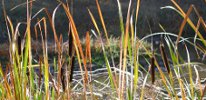
Training
CNPS Vegetation and Habitat Rapid Assessment Method Workshop
COST: $150.00
Payable at workshop
REGISTRATION FOR THIS PROGRAM IS CLOSED
Instructor Information
Ms. Julie Evens
Vegetation Ecologist
California Native Plant Society
Dr. Todd Keeler-Wolf
State Vegetation Ecologist
California Department of Fish & Game
Anne Klein
Vegetation Ecologist
California Native Plant Society
Contact
Grey Hayes
grey@elkhornslough.org
(831) 274-8700
Sponsors
Description
See also: Vegetation Assessment Methods, Habitat RestorationThe California Native Plant Society (CNPS), Department and Fish and Game (CDFG), and Elkhorn Slough Coastal Training Program partnered to present a public vegetation and habitat workshop on Mon.-Tues. September 27-28, 2004. This workshop consisted of a slide presentation and field training on CNPS vegetation survey protocols and fine-scale vegetation classification and mapping. The workshop was located in the Santa Cruz Mountains, which has a diverse complex of vegetation types, including mixed evergreen, redwood, chaparral, oak woodland, and riparian habitats. The class was designed for botanists, ecologists, wildlife biologists, conservationists, biological consultants, and federal and state employees. Participants should have a general understanding of the subject matter. Primary instructors were Julie Evens and Anne Klein, Vegetation Ecologists with the California Native Plant Society, and Todd Keeler-Wolf, State Vegetation Ecologist with the Department of Fish and Game. During the workshop participants learned about the CNPS Rapid Assessment method, a standard sampling protocol used to define habitats and vegetation types at a fine-scale. They discussed relationships of this protocol to other sampling methods, as well as their actual and projected uses. An emphasis was placed on floristic vegetation classification and mapping, particularly use of the CNPS and National vegetation classification systems, as documented in the book "A Manual of California Vegetation". The intent of the rapid assessment protocol is to maximize the amount of information collected about all vegetation types and habitats across broad regions in a limited amount of time. Using the one-page field form, you can collect and compile the following information: • Type, location, and distribution of vegetation types (down to the alliance level and below) • General composition and abundance information on the dominant, characteristic, rare, and exotic plant species • General site environmental factors • Wildlife habitat stage • Validation of vegetation mapping delineations (down to alliance level and below) • Site quality and intensity of disturbances The CNPS methods are useful for collecting basic quantitative vegetation and habitat information sufficient for identification and verification of alliances (per the Manual of California Vegetation), Wildlife Habitat Relationships (WHR) habitats, and other classification schemes. It can be used for field-based vegetation/habitat mapping and for quick inventory, validation, and ranking of the full suite of vegetation and habitats in any natural area or other management area. Thus, they can provide people with efficient tools for natural resource inventorying and planning. CNPS, CDFG, Calif. State Parks, U.S. National Park Service, other state and federal agencies, and consulting firms are using the methods to quickly and quantitatively inventory and map vegetation types in several projects throughout the state. For example, they are used in conjunction with a WHR Validation study at Point Reyes National Seashore. It is also being used to inventory and map vegetation for conservation and management of the Santa Monica Mountains, San Dieguito River drainage, Napa County, and Western Riverside County.
Documents and Publications
| DOCUMENT | AUTHOR / SOURCE |
|---|---|
| WORKSHOP MATERIALS | |
| Agenda: CNPS Vegetation and Habitat Rapid Assessment Method Workshop PDF, 25KB |
|
| Contact List: CNPS Vegetation and Habitat Rapid Assessment Method Workshop PDF, 8KB |
|
| Data from Workshop Field Component: Vegetation Associations from Western UCSC campus PDF, 917KB |
|
| Field Plot Locations for Survey Example at UCSC PDF, 215KB |
|
| Presentation: A Standardized Rapid Assessment of Vegetation and Habitat. PDF, 793KB |
T. Keeler-Wolf & A. Klein |
| OTHER INFORMATION | |
| CNPS % Cover Diagram PDF, 1.8MB |
Elkhorn Slough Coastal Training Program |
| CNPS Releve Field Form PDF, 297KB |
California Native Plant Society CNPS 2004 |
| CNPS Releve Protocol PDF, 139KB |
California Native Plant Society Vegetation Committee CNPS 2004 |
| CNPS Vegetation and Rapid Assessment Field Form PDF, 105KB |
California Native Plant Society CNPS 2004 |
| CNPS Vegetation and Rapid Assessment Protocol PDF, 100KB |
California Native Plant Society Vegetation Committee CNPS 2004 |
Links
CDFG Arcview arial photo files from 2004. The California Spatial Information Library, California Digital Ortho (Quarter) Quads (DOQQs)
http://casil.ucdavis.edu/casil/usgs.gov/doqq/
CNPS Home: Organization information, California vegetation information and more!
http://cnps.org/
Natureserve U.S. National Vegetation Classification
http://www.natureserve.org/aboutUs/projects.jsp#ecosystems
The Manual of California Vegetation-Online
http://davisherb.ucdavis.edu/cnpsActiveServer/index.html
Questions and Answers
Submit a question on this subject and we'll provide an answer. coastaltraining@elkhornsloughctp.org
